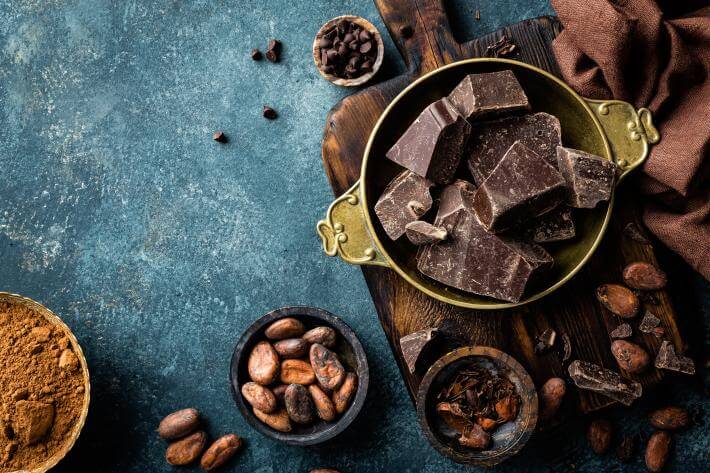Carob vs. Chocolate
What is carob? Is it better for you than chocolate? Nutrition Diva weighs the pros and cons.
Monica Reinagel, MS, LD/N, CNS

Listen
Carob vs. Chocolate
Aly writes: “I recently bought some carob at my local organic food store on a whim and now I’m wondering about its nutritional profile. Is it a healthy alternative to chocolate? What are the pros and cons?”
What is Carob?
Carob is an ingredient that you only seem to run into in health food stores—or in the “healthy foods” aisle of the regular grocery store. It’s usually used as an alternative to chocolate and you’ll find it in a number of chocolate-like formats: as a powder for baking, chips that you can add to cookies, or as a flavoring in candy, baked goods, and hot beverage mixes. So, what are the advantages of substituting carob for chocolate?
What are the Health Benefits of Carob?
Perhaps the primary benefit of carob as a chocolate substitute is that, unlike cocoa, carob contains no caffeine or theobromine. Both of these chemicals (which belong to a family of substances called methylxanthines) are stimulants; while caffeine works primarily on the central nervous system, theobromine stimulates the cardiovascular and pulmonary systems.
These stimulating effects are sometimes beneficial. As I talked about in my article on Benefits of Caffeine, caffeine has neuroprotective effects, reducing your risk of Parkinson’s and Alzheimer’s disease. Theobromine, on the other hand, dilates (or widens) blood vessels and increases urine output, which can help lower blood pressure. It’s also been found to act as a cough suppressant and dilate the bronchial tubes, making breathing easier. Both caffeine and theobromine affect the production and uptake of neurotransmitters in ways that can lift your mood.
However, it’s also possible to be over-stimulated. Both caffeine and theobromine can cause adverse effects such as sleeplessness, jitters, or anxiety if consumed in excessive quantities. The amount of caffeine and theobromine in chocolate won’t bother most people but for those who are very sensitive to stimulants, even small amounts can create problems.
Theobromine is what makes chocolate toxic to dogs, by the way—which is why “chocolate”-flavored dog treats are actually made with carob. To my knowledge, dogs don’t really crave chocolate (or carob), so I’ve never really understood why people make fake-chocolate dog treats. But there’s a lot about dog- culture I don’t get. That’s why I listen to The Dog Trainer’s podcast.
Health Benefits of Chocolate
Carob doesn’t contain stimulants. However, it also doesn’t contain those flavanols that we hear so much about. I know a lot of people who justify their daily dose of dark chocolate on the strength of the Health Benefits of Chocolate—and carob would not offer the same advantages.
But, in my mind, the biggest disadvantage of carob as a chocolate substitute is that it doesn’t really taste like chocolate at all. About all it has in common with chocolate is the color. Then again, it’s amazing how much of our sense of taste has to do with color. Researchers have found, for example, that if you add yellow food coloring to vanilla pudding, people will say it tastes like lemon. And Cheetos without the florescent orange powder don’t taste as cheesy. Nonetheless, if you’re a real chocolate lover, I don’t think that carob-flavored alternatives are going to fool you.
Does Chocolate Cause Headaches?
Chocolate is often said to be a trigger for migraine headaches but several studies have failed to find a consistent link. If you find that avoiding chocolate helps you reduce or avoid headaches, that’s probably all the evidence you need. But if you get headaches whether or not you eat chocolate, there may be no reason to deprive yourself.
Allergies to chocolate are extremely rare. Often, what people perceive as a chocolate allergy is actually an allergy to milk or nuts that are also present. Your chances of being allergic to chocolate are about the same as being allergic to carob. Either way, the two plants are completely unrelated, so if you are allergic to one, you can probably safely eat the other.
Nutritional Comparison of Chocolate and Carob
How do chocolate and carob compare nutritionally? Compared with plain cocoa powder, plain carob powder is lower in fat but significantly higher in carbohydrates and sugar. However, nobody eats plain cocoa or carob powder. Products made with either one will have varying amounts of fat and sugar added to them and you need to compare the nutrition facts labels to see how they stack up.
In terms of other nutrients, carob boasts a significant amount of calcium—about three times as much as you’d get from cocoa. But cocoa has the advantage in terms of iron, magnesium, copper, and manganese.—and of course, those flavanols I mentioned earlier. But let’s be frank: most of us aren’t eating chocolate for the nutrition.
The Bottom Line
Here’s the bottom line on chocolate vs. carob: For anyone with a sensitivity to chocolate or any of its active ingredients, such as caffeine or theobromine, carob offers a chocolate-like (or at least brown-colored) alternative. Otherwise, chocolate appears to offer a few extra health benefits. But either way, be sure to keep an eye on how much sugar, fat, and calories are riding along.

